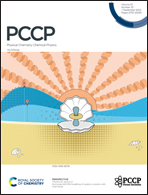Probing molecular interactions of semiquinone radicals at quinone reduction sites of cytochrome bc1 by X-band HYSCORE EPR spectroscopy and quantum mechanical calculations†
Abstract
Quinone redox reactions involve a semiquinone (SQ) intermediate state. The catalytic sites in enzymes stabilize the SQ state via various molecular interactions, such as hydrogen bonding to oxygens of the two carbonyls of the benzoquinone ring. To understand how these interactions contribute to SQ stabilization, we examined SQ in the quinone reduction site (Qi) of cytochrome bc1 using electron paramagnetic resonance (ESEEM, HYSCORE) at the X-band and quantum mechanical (QM) calculations. We compared native enzyme (WT) with a H217R mutant (replacement of histidine that interacts with one carbonyl of the occupant of Qi to arginine) in which the SQ stability has previously been shown to markedly increase. The 14N region of the HYSCORE 2D spectrum for SQi in WT had a shape typical of histidine residue, while in H217R, the spectrum shape changed significantly and appeared similar to the pattern described for SQ liganded natively by arginine in cytochrome bo3. Parametrization of hyperfine and quadrupolar interactions of SQi with surrounding magnetic nuclei (1H, 14N) allowed us to assign specific nitrogens of H217 or R217 as ligands of SQi in WT and H217R, respectively. This was further substantiated by qualitative agreement between the experimental (EPR-derived) and theoretical (QM-derived) parameters. The proton (1H) region of the HYSCORE spectrum in both WT and H217R was very similar and indicative of interactions with two protons, which in view of the QM calculations, were identified as directly involved in the formation of a H-bond with the two carbonyl oxygens of SQ (interaction of H217 or R217 with O4 and D252 with O1). In view of these assignments, we explain how different SQ ligands effectively influence SQ stability. We also propose that the characteristic X-band HYSCORE pattern and parameters of H217R are highly specific to the interaction of SQ with the nitrogen of arginine. These features can thus be considered as potential markers of the interaction of arginine with SQ in other proteins.



 Please wait while we load your content...
Please wait while we load your content...